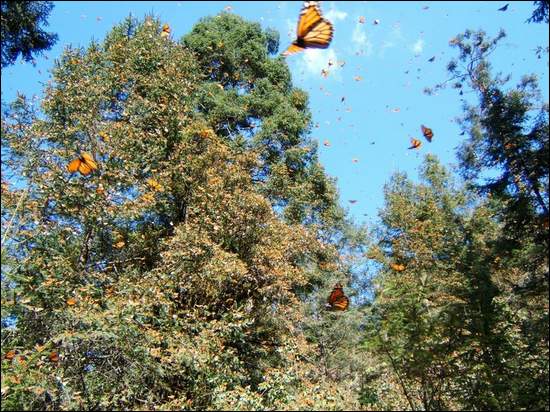Monarch butterflies returning to the sky
Journal and Courier
By Kevin Smith
May 7, 2008
 |
Millions of monarch butterflies cling to trees and take to the sky in their overwintering grounds in the fir forests of Michoacan, Mexico. The monarch butterfly migrates every fall to Mexico, then returns to North America in the spring to reproduce in stands of milkweed and nectar plants, which are increasingly less plentiful. |
If the pungent smells of bright tree blossoms are not enough to show that spring has finally arrived, evidence of one of the great journeys in nature is a sure sign.
During the past few weeks, monarch butterflies have reappeared in the Midwest as they progress on a 4,000-mile journey across North America from their winter habitat in Michoacan, Mexico.
The first official siting in Indiana was reported in western Tippecanoe County on April 20, according to journeynorth.org.
The habitat of the monarch butterfly and its young is under threat both in Mexico and the United States. Conservationists, entomologists and a growing number of concerned citizens and students are now working to preserve the future of the orange and black butterfly.
Millions of monarchs
In January, Katie England participated in a Purdue University study abroad trip to the Monarch Butterfly Biosphere Reserve, a 15-acre mountainous area in eastern Michoacan where an estimated 150 million monarchs spend the winter each year.
"It's incredible. I've been fortunate to visit a lot of places, but this was the most awe-inspiring," said England, a Purdue graduate student in entomology. "We went into one sanctuary, and there were so many monarchs flying around our heads that you could hear their wings. There were 1 (million) or 2 million altogether. They looked like leaves on the trees, but when you get close you can see them moving. Its really incredible."
Mexican habitat threatened
The sanctuaries the Purdue students visited were set up by the Mexican government in 1986. Maintaining the preserves has been a problem, though, due to pressure from the area's 200,000 residents who want to farm the land.
In 1998, the conservation group Alternare was established to work with locals to keep the sanctuaries safe from farmers and developers.
"Alternare's goal is to provide conservation through helping the locals meet their needs," England said. "They educate the locals on farming and better use of lumber so they don't have to use the trees for housing."
Steve Yaninek, chairman of the Purdue Entomology Department, leads the annual trip to the wintering ground in Mexico.
He developed the 10-day educational excursion, which takes place over winter break, as a mini-course several years ago.
He said that the progress made by Alternare in the past 10 years has been remarkable.
"Some of the first people trained who left the area are now coming back into the community to help continue the work. It's a very good thing to see," Yaninek said.
Milkweed disappearing
While efforts in Mexico appear to be preserving the fir forests where the monarchs winter, a drastic decrease in milkweed in the United States -- the only plant on which they lay their eggs and the only food source for the monarch caterpillars -- is proving problematic during the spring and summer months when they are in the United States to reproduce.
"In the Midwest, where so much of the land is agricultural, it limits the amount of milkweed and threatens the monarchs," Yaninek said. "The things that we do here in our garden, our county and state can be positive."
Milkweed is toxic to farm animals so farmers are careful to eradicate it from fields where they grow hay and feed corn.
But organizations and individuals who know that milkweed is vital to the life cycle of the monarch are starting to intentionally plant it in their home landscapes and in public places.
England's Monarch experience, it seems, has given her this impetus.
"I've been thinking about planting some milkweed in my backyard."
For more photos from the Purdue University Department of Entomology study abroad course, please visit http://www.entm.purdue.edu/studyabroad/monarchs/photos.html.
|